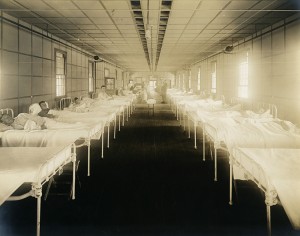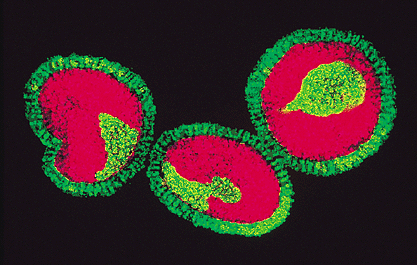Spanish Flu 100
Thursday, August 2nd, 2018August 2, 2018
One hundred years ago, in 1918, the Spanish flu began taking its deadly toll around the world. The Spanish flu was the worst outbreak of influenza, or flu, in history. Medical historians estimate that from 1918 through 1919, the Spanish flu killed at least 600,000 people in the United States and 20 million to 50 million people worldwide. The Spanish flu was the first and most severe of three pandemics (worldwide occurrences) of influenza in the 1900’s. Less severe pandemics occurred in 1957 and in 1968.

The Camp Jackson Base Hospital in South Carolina is filled with Spanish flu patients in the fall of 1918. Credit: Otis Historical Archives/National Museum of Health and Medicine
The Spanish flu struck in the final year of World War I (1914-1918), while many European nations were concentrating on war efforts. Many soldiers died of influenza, and troop concentrations and movements helped spread the disease. Most countries at war did not publicly acknowledge the number of deaths from influenza because of strict wartime censorship. The pandemic became known as the Spanish flu because the disease was widely reported in Spain, which remained neutral during the war.
Spanish flu caused symptoms similar to other influenza infections, including fever, chills, headaches, body aches, and fatigue. However, many people suffering from Spanish flu quickly developed severe pneumonia (inflammation of the lungs) and pulmonary edema (excess fluid accumulation in the lungs), causing victims to suffocate. Unlike other varieties of influenza, which most seriously affect infants and the elderly, the Spanish flu killed mainly young, healthy adults between 20 and about 40 years of age.
Medical historians believe the virus that caused Spanish flu, like many strains of influenza virus, probably originated in Asia. However, the first reported outbreaks of the disease occurred in the United States. The disease quickly spread to Europe, Asia, Africa, and South America. During the height of the pandemic, the huge number of deaths severely disrupted many societies. Many countries tried various public health measures to contain the pandemic. In the United States, several cities closed schools, churches, theaters, and other public gathering places. By the end of 1919, the pandemic had largely ended.
Scientists have long sought to discover why the particular variety of influenza that caused the Spanish flu was so deadly and spread so quickly. In the 1990’s, they identified preserved lung tissue of victims of the disease that still contained the genetic information from the Spanish flu virus. They confirmed it as a variety of H1N1, one of several types of influenza viruses that can infect both people and certain animals, such as swine. Scientists believe birds are the original source of the Spanish flu and other pandemic influenza viruses. Birds carry many varieties of influenza viruses and in rare occasions transmit these viruses to human beings. In 2005, scientists re-created the Spanish flu virus through a process called reverse genetics. By studying the virus, they hope to discover why the disease spread so quickly and why it was so deadly. In addition, scientists can study the Spanish flu virus to develop new vaccines and treatments to prevent or contain future influenza outbreaks.



